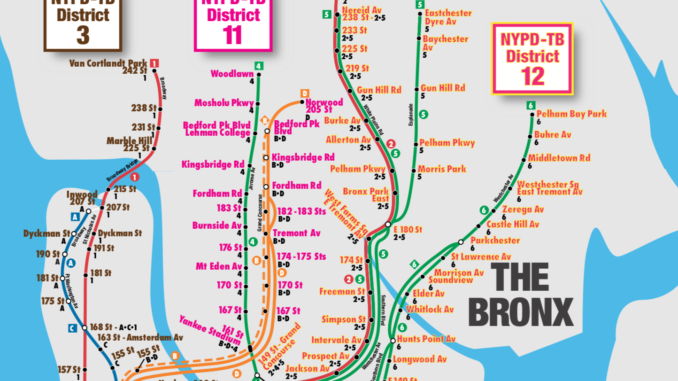
By Kevin Deutsch
[email protected]
The NYPD made more arrests for subway fare evasion in the Bronx during the first three months of 2019 than any other borough, with black and Latinx straphangers making up an overwhelming majority of those charged citywide, new data shows.
The NYPD Transit Bureau’s three Bronx districts accounted for at least 345 straphanger arrests during the period covered by the data, or 35 percent of the citywide total. Across the five boroughs, police made 992 arrests for fare evasion during the period, including 142 in which the borough of arrest was not recorded, the data shows.
Citywide, 87 percent of arrested straphangers were black or Latinx, the data shows, despite the fact that those minority groups make up fewer than 30 percent of all city residents, respectively.
The NYPD also issued 18,757 summonses for fare evasion during the three-month period, records show. Of those, 5,188 were issued in the Bronx, with the borough accounting for 28 percent of all fare beating summonses.
Citywide, 70 percent of straphangers who received fare evasion summonses in lieu of being arrested were black or Latinx, the data shows.
Several Bronx subway stations ranked among the top in the city for fare bearing arrests of black and Latinx subway riders, including the 3rd Avenue-149th Street, Hunts Point Avenue, 170th Street, and Tremont Avenue stations, according to the NYPD data.
The NYPD did not release an overall statistical breakdown for arrests and summonses by station, despite a city law requiring disclosure of such data.
The number of arrests for fare evasion were down significantly from the same period last year, when 2,254 straphangers were arrested citywide, records show.
About 5,000 straphangers were arrested and 47,000 issued summonses in 2018 for subway fare evasion. About 90 percent of those arrested, and 68 percent of those issued summonses, were black or Latinx, records show.
Neither the NYPD nor the MTA responded to an email seeking comment Monday.
Critics of the agencies’ fare beating policies said the overrepresentation of black and Latinx New Yorkers in the new data shows that the NYPD isn’t working to curb biased enforcement.
“The NYPD has made no steps whatsoever to mitigate the bias that’s apparent and evident in their fare evasion policing tactics,” said City Councilman Rory Lancman, who championed the legislation requiring the NYPD to publicly release fare evasion data.
The Bronx District Attorney’s Office has said it encourages the NYPD to issue summonses rather than make arrests – unless there is what the office calls a “public safety exception” – but the new data shows police are frequently hauling Bronx farebeaters to jail anyway.
The policy of the Bronx DA’s Office is to decline to prosecute theft of services for fare evasion “where that charge appears without any other charge,” Patrice O’ Shaughnessy, Director of Communications for the DA’s Office, has said.
NYPD officers aware of that policy often add additional charges, such as criminal trespass and attempted forgery (a charge commonly brought against suspects who bend empty MetroCards in a way that allows them to bypass turnstile scanners), according to transit activists and public defense organizations.
“Fare evasion is an essential crime of poverty for our clients and other low-income New Yorkers who are trying to access employment, education, or critical services,” Anthony Posada, Supervising Attorney of the Community Justice Unit at The Legal Aid Society, said recently. “Despite efforts by local district attorneys’ offices to scale back fare beat prosecution, the New York City Police Department continues to target Black and Brown people at a disproportionate rate.”
The city’s fare evasion policies have come under renewed scrutiny this year following New York City Transit President Andy Byford’s announced crackdown on train and bus fare beaters, who the authority estimates cost the system more than $225 million in revenue last year.
